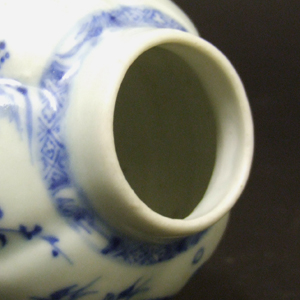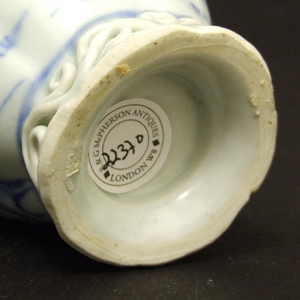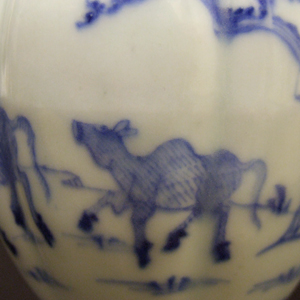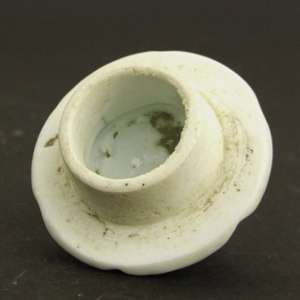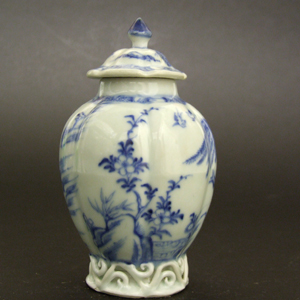
CA MAU CARGO 1723 – 1735 Yongzheng Period
A Rare Ca Mau Cargo Blue and White Porcelain Tea Canister and Cover, Yongzheng Period 1723-1735. Decorated with the So-Called `Boy on Buffalo` Pattern. A Boy Sits on Top of a Large Water Buffalo with his Arm Outstretched While a Smaller Water Buffalo Follows Behind.
SOLD
- Condition
- Perfect with a good glaze.
- Size
- Height : 13 cm (5 inches)
- Provenance
- A Private English Collection of Chinese Blue and White Porcelain.
- Stock number
- 22370
- References
- For blue and white porcelain tea canisters of this pattern sold as part of a tea sets see : Made in Imperial China, 76,000 Pieces of Chinese Export Porcelain from the Ca Mau Shipwreck, Circa 1725. Sotheby`s Amsterdam, 29,30 & 31 January 2007, lots 366,368,369 and 370 and six canisters without covers lot 377. For three canisters with covers see : Tau Co Ca Mau, The Ca Mau Shipwreck 1723 - 1735 ( Nguyen Dinh Chien, Na Noi, 2002 ) page 168, plate 193.
Information
The Ca Mau Cargo :
Dating is often one of the most contentious issues when researching a shipwreck site. In this case, an approximate date is not difficult to ascertain. Coins that date from the Kangxi Period (1662-1722) were recovered from the wreck. Chinese coins, like their Western counterparts, were often in circulation over a long period of time, therefore these coins do not necessarily give a Kangxi date for the wreck, but do provide a `not before` date. Most importantly of all, a group of wine cups were recovered from this shipwreck, bearing a four-character Yongzheng mark, indicating that they were made during the Emperor Yongzheng`s reign, which lasted from 1723 to 1735. The style of the potting, glazing and painting of these cups are all consistent with other known pieces from the Yongzheng period. Other porcelain removed from the wreck is also consistent in style, which suggests that all the porcelain was made during the same period. For a number of years now, I have suspected that a considerable amount of porcelain ascribed to the reign of the Emperor Kangxi (1662-1722) was in fact made during the shorter reign of his son Yongzheng (1722-1735). After studying the two styles over a long period of time, it has become apparent to me that many pieces of Yongzheng porcelain previously had been wrongly identified as belonging to the better-known period of Kangxi. The Ca Mau wreck, I believe, helps re-establish the importance of the large output of Chinese export porcelain during the Yongzheng period. It must be remembered, however, that a dynastic change did not necessarily influence the styles of Chinese export porcelain. The first year of Yongzheng by no means saw a sudden shift in ceramic styles. The Chinese porcelain export trade was a commercial enterprise and popular patterns were used for as long as demand continued. Change as well as technical innovation occurred but it was the changing demands of customers that brought about a change in style from the late Kangxi period to the Yongzheng Period, indeed styles always change because producers try to understand what will sell at any given moment. These changes are evident in the ceramics recovered from the Ca Mau cargo. The use of `Pencilled` decoration is an example. The decoration is painted in outline only, without the use of tonal washes. The style is found in some late Kangxi porcelain but it reached maturity during the Yongzheng period. The profile of some of the tea bowls became less rounded, and the manner of painting faces and hair also changed during this period. All these elements are to be found in the porcelain recovered from the shipwreck. The cargo forms a most useful historical bridge between the Kangxi porcelain of the Vung Tau Cargo produced during the 1690`s and the Qianlong porcelain produced in 1750-1751, recovered from the wreck of the Geldermalsen, now known as the Nanking Cargo.
Boy on Buffalo :
The water buffalo (Bubalis Arnee) is native to Asia where 97% of the worlds population live. It is an important beast of burden in China, especially the south of the country where it is used for ploughing the semi-aquatic rice fields of the region. It is also used for it`s meat as well as it`s milk and is sacrificed at some festivals. It is a large heavy tough animal, that is powerful despite only needing poor feed. In China a small boy, sometimes playing a flute, on top of a buffalo represents the submission of wild power to a child. For a Transitional blue and white porcelain bowl depicting a version of this design and inscribed with a poem reading "A Young Shepard Rides on the Back of a Buffalo Going Home" "Blowing a no Name Melody Freely and Randomly with a Short Flute." see `Sold Items` stock number 21204. Designs with a boy on a buffalo can also be found on English soft-paste porcelain of the 18th century as well as late 18th and early 19th century English and Welsh transfer printed blue and white pottery. These designs are referred to to as `The Boy on the Buffalo Pattern`.
